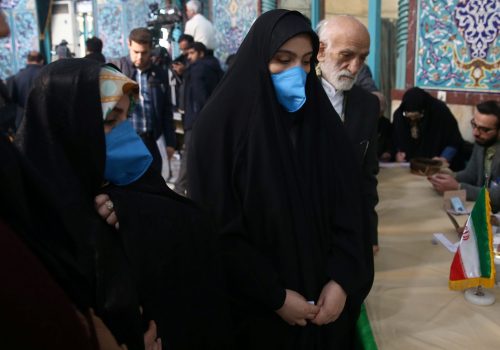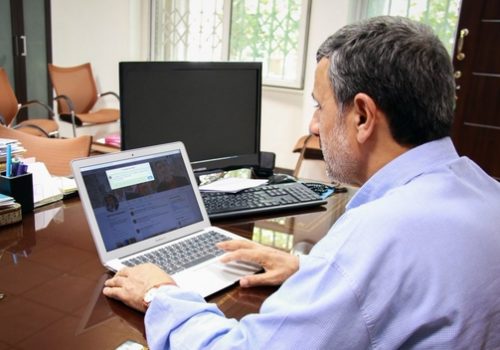Mahmoud Ahmadinejad, former president turned ‘popstar,’ plans to run again
“Your brother Mahmoud Ahmadinejad,” signed the former hardline Iranian president in a July letter addressing Saudi Arabia’s crown prince. In the letter, he called on Tehran and Riyadh to join forces to find a peaceful solution for the Yemen War. Ahmadinejad never received a response. In fact, most of his letters to world leaders go unanswered, including three written to US President Donald Trump over the past few years.
Every so often, Iran’s most polarizing ex-president makes headlines for his attention-grabbing activities, usually in the form of English tweets commenting on an array of topics—including, most recently, the Black Lives Matter protests—which Ahmadinejad reportedly writes himself for the most part. The irony, of course, being that Twitter, along with Facebook and YouTube, were banned under Ahmadinejad’s presidency after the 2009 post-election protests known as the Green Movement, which resulted in a brutal crackdown that killed dozens and led to the arrest of thousands.
Aside from pontificating on social media, Ahmadinejad also holds a seat on the Expediency Council, an appointed advisory body. Despite being an outspoken critic of the Iranian government, the ex-president has managed to avoid house arrest and imprisonment. Although Ahmadinejad is considered by many to be no longer relevant in domestic politics, he refuses to fade away.
In recent months, there have been talks that the two-term ex-president is planning to run in the 2021 Iranian presidential elections. The speculation seemingly started when Ahmadinejad began to make a series of provincial visits three months before the February parliamentary elections. Some analysts assumed that the campaign-like visits were attempts to lobby support for other candidates or perhaps himself. At the time, Ahmadinejad’s office denied the speculation, given that campaigning that early into the race is illegal, but the chatter continued.
Social media loves Mamouti
Taking note of his sudden resurgence on the domestic stage, many Iranians started posting memes and deepfakes about “Mamouti,” (#مموتی) the nickname for Ahmadinejad. One popular post is a deepfake of Ahmadinejad as Game of Thrones character Daenerys Targaryen, the mother of dragons, as she delivers a fiery speech.
Some users have also shared deepfakes of Ahmadinejad as singers Billie Eilish (below), Nicki Minaj, Jennifer Lopez, and Selena Gomez in music videos. Another popularly shared deepfake depicts Ahmadinejad as Bob Ross, the late American painter and host of The Joy of Painting, a popular program on Iranian state media.
‘Mamouti Ross’ tells his audience, “Today I came to talk about the past. Remember what a better era it was? The situation was not terrible as now,” eluding to how the economy fared under Ahmadinejad versus Hassan Rouhani’s presidency.
The Ahmadinejad years (2005-2013) were marred by the strangling of the middle class, in part due to his mismanagement, inflationary economic policies and multilateral sanctions imposed on Iran over its nuclear program. While inflation was rampant and the rial lost its value, it is even worse today—though it’s worth noting that his presidency enjoyed high oil prices. Ahmadinejad was also an embarrassment on the world stage for many Iranians owing to his Holocaust denial and claims that others saw a “halo” around his head when he addressed the 2005 United Nations General Assembly, which stands in stark contrast to the well-spoken and rational Rouhani. But that wasn’t the only difference between the two presidencies. Ahmadinejad’s economic populism made lower-income Iranians his social base during his presidency, whereas Rouhani couldn’t be more different with his private sector-oriented economic policies and shunning of populism.
Some memes portray the traditionally bearded Ahmadinejad with a mustache and sunglasses, which caught enough attention for Tehran daily, Hamshahri, to publish a piece on August 14 explaining that the images were photoshopped. Alongside the Mamouti posts, there are photos of Ahmadinejad and videos of speeches accompanied by a series of hashtags, often referring to his bahar, or spring coalition. Among those hashtags are: #زنده_باد_بهار (long live Spring), #احمدی_نژاد_جان_من_است (Ahmadinejad is my life), #احمدی_نژاد_حذف_شدنی_نیست (Ahmadinejad is forever), and #احمدی_نژاد_مرد_افتخارات_ایران (Ahmadinejad is the pride of Iran).
Will Ahmadinejad run?
Ahmadinejad addressed speculation indirectly during an interview with US IRAN TV, a Boston-based YouTube channel. Ahmadinejad said on June 14 that he had not thought about participating in the presidential election and doesn’t intend to. This was followed by an interview with Hamshahri on July 3, in which Ahmadinejad was asked about his predictions for 2021. He said, “I don’t even think about the elections. We must think about today… Many great things can happen in one year.”
This isn’t the first time the controversial president has tried to run as a candidate after his two terms. In April 2017, Supreme Leader Ayatollah Ali Khamenei asked Ahmadinejad to stay out of the election when rumors emerged he was gearing up to run again. Despite this, the former president registered alongside his former Vice President, Hamid Baghaei. The Guardian Council, a vetting body dominated by clerics chosen by the Supreme Leader, disqualified both a week later. At the time, a Tehran-based analyst described Ahmadinejad as an “unwanted guest in the election” and that he would remain politically active to make a “quasi-opposition face for himself” in the future. That future being now, it seems.
Khamenei, who had defended the 2009 election outcome that gave Ahmadinejad a disputed second term, had a public rift with the then president over picking an intelligence minister in 2011. For three years now, the Supreme Leader’s office has turned down requests by Ahmadinejad to meet with Khamenei, according to the former president’s cultural advisor. Since Ahmadinejad’s second term ended in 2013, two members of his inner circle have been sentenced to prison, including former Vice President Baghaei.
On August 10, the Guardian Council spokesman recommended that candidates that had been disqualified in the past should not register in the 2021 election, which was an obvious reference to Ahmadinejad.
With the former president unofficially out of the race before it even begins, Ahmadinejad’s former energy minister (2005-2009) Parviz Fattah is likely to take the lead.
The next likely candidate
As part of Khamenei’s “second phase of the revolution,” hardliners have been consolidating power and there’s a new breed of “young and pious” that are taking the helms of domestic politics. Amongst those are Fattah, a member of the Islamic Revolutionary Guard Corps (IRGC) and the head of the Mostazafan Foundation. The organization is controlled by the Supreme Leader to help “the oppressed” by using revenues from properties confiscated after the 1979 revolution to aid the poor. Fattah has touted himself as being close to assassinated Quds Force commander Qasem Soleimani and is positioning himself to be a part of the anti-corruption charge lead by Judiciary Chief Ebrahim Raisi, who lost the 2017 presidential election to Rouhani.
In an interview with state media on August 8, Fattah called out several entities and officials, such as Gholam Ali Haddad-Adel—the father-in-law of the Supreme Leader’s son—and the former speaker of parliament, for occupying eight thousand square meters of property in affluent north Tehran. Interestingly, Fattah also singled out his former boss, Ahmadinejad, for having an 1,800 square meter office in north Tehran (contrary to the populist ex-president’s claims of living humbly). Fattah openly naming officials is surprising and suggests that he is aggressively pushing an anti-corruption platform in a country where the average Iranian is increasingly resentful of the elites.
The following day, Ahmadinejad’s office issued a statement saying that the office location wasn’t their choice and that they are willing to vacate the property. Though there is much speculation surrounding Fattah, he claims to not have political ambitions and wants to remain head of the Mostazafan Foundation.
With many Iranians disenchanted with the political process—as evidenced by the parliamentary elections which had the lowest recorded turnout in the Islamic Republic’s history—it’s unclear how many will bother to vote in the 2021 presidential elections. The disqualification of reformists and low turnout helped the hardliners in February, which is likely to be the case next year—it’s just a matter of which one.
Holly Dagres is editor of the Atlantic Council’s IranSource blog, and a nonresident fellow with the Middle East Programs. She also curates The Iranist newsletter. Follow her on Twitter: @hdagres.
Subscribe for more from IranSource
Sign up for the IranSource newsletter, which provides a holistic look at Iran’s internal dynamics, global and regional policies, and posture through unique analysis of current events and long-term, strategic issues related to Iran.
Image: Former Iranian President Mahmoud Ahmadinejad delivering a speech. (Ahmadinejad's official Twitter account)


